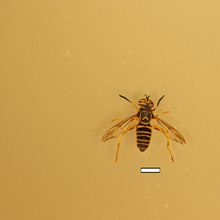User:ReeseWB/sandbox
 | This is a user sandbox of ReeseWB. You can use it for testing or practicing edits. This is not the sandbox where you should draft your assigned article for a dashboard.wikiedu.org course. To find the right sandbox for your assignment, visit your Dashboard course page and follow the Sandbox Draft link for your assigned article in the My Articles section. |

Black Caterpillar Hunter beetle (Calosoma sayi). Found in Milledgeville, Ga. on August 30th, 2022. Class: Insecta Order: Coleoptera Family: Carabidae Genus: Calosoma Species: sayi Habitat: Located on the eastern side of North America, these beetles are likely to be found in wooded areas and gardens Feeding Habits: Feed primarily on caterpillars or other insect larvae. This beetle can also deploy a chemical to deter a predator. It was described by Pierre François Marie Auguste Dejean in 1826 https://bugguide.net/node/view/3015

Northern Walkingstick (Diapheromera femorata). Found in Milledgeville, Ga. on September 22nd, 2022. Class: Insecta Order: Phasmida Family: Diapheromeridae Genus:Diapheromera Species: femorata Habitat: North America, found in deciduous forests. Feeding Habits: Feeds on many types of plants, however it seems to prefer leaves from oak and hazelnut trees. These walkingsticks often do not have wings. Thomas Say, 1824 https://animaldiversity.org/accounts/Diapheromera_femorata/#:~:text=Physical%20Description,the%20length%20of%20the%20body.

Eastern Hornet Fly (Spilomyia longicornis). Found in Oxford, Ga. on October 8th, 2022. Class: Insecta Order: Diptera Family: Syrphidae Genus: Spilomyia Species: longicornis Habitat: Found in the Eastern United States and some parts of Canada. Found near flowers in hardwood forests. Its black and yellow coloration is mimicking wasps, however the fly itself cannot sting. Feed on nectar of plants whose flowers produce a lot of pollen. Friedrich Hermann Loew, 1872 https://bugguide.net/node/view/5906

Horned Passalus Beetle (Odontotaenius disjunctus). Found in Milledgeville, Ga. on November 2nd, 2022. Class: Insecta Order: Coleoptera Family: Passialidae Genus: Odontotaenius Species: disjunctus Habitat: Found in the southeat US in heavily wooded forests. Live in colonies with their offspring in old dead trees and logs. Parasitic infections are common. They eat the trees that they live in and can even produce a small high pitched sound when threatened. Johann Karl Wilhelm Illiger, 1800 https://bugguide.net/node/view/2864
